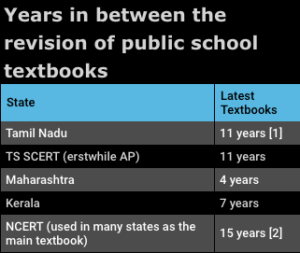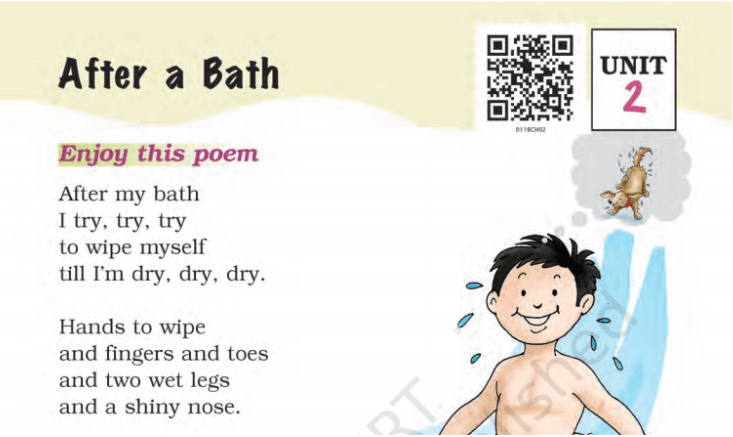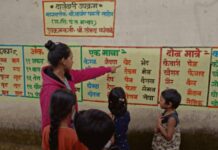This is the second instalment of a two-part series on how and why our textbooks fail to meet the lofty ambitions set by national education policies. Click here to read part one.
The first article in this series explored how textbooks fail to meet the objectives of curricular frameworks like the National Curriculum Framework (NCF). This is often a conscious tradeoff made by textbook authors who face multiple limitations while attempting to align practical textbooks to theoretical policy documents.
So, if textbooks underdeliver by design, then is the original curriculum framework an effective starting point for formulating education at all?
The answer is a resounding yes! Just because the ingredients of a dish are bad, they do not malign the principles of a balanced diet. The easiest way to ensure that the curriculum serves its purpose is to draft the curriculum, implement it, measure its effectiveness, iterate, and improve. The revision of curriculum and allied materials allows space for regular dialogue to improve the design of the course, and will accelerate efforts to bridge gaps between vision statements and published classroom materials.
How can curricula be evaluated meaningfully?

Many states have these objectives listed in their education policies or vision notes. For instance, in 2018 Tamil Nadu proposed to ensure that the curriculum, syllabus, and textbooks are iterated once every five years, to reflect the changing worlds of children.
The effectiveness of this curriculum can be evaluated by drawing inspiration from Bradley’s model or Tyler’s objective centred model, resulting in some key measures relevant to public education in India.
- Impact: Have the students achieved the learning objectives or goals outlined in the curriculum at the defined development stage? For instance, can a child solve meaningful problems in grade 2?
- Content Analysis (desk research): Is the curriculum comprehensive, complete, and accurate? Does it follow a coherent, logical, and age-appropriate progression? For instance, is the child taught to pose mathematical problems? What skills does the child need to build (both within and outside the subject’s scope) to pose such questions?
- Classroom Practice: Is the practice aligned to the expected curricular objectives? Does it espouse the same principles and values of education as outlined? For instance, the curriculum requires discussion as a teaching practice in the classroom, but does the teacher discuss the concept, or do they merely solve the problem?
- Comparative Study: What is taught to children in Tamil Nadu? How is it similar or different to a child in Andhra Pradesh, Delhi, or the Philippines? For instance, children in Australia are taught fundamentals of fractions in Grade 1, whereas the NCERT introduces fractions in Grade 4.
So, ultimately, how can meaningful curricula be developed in India?
As you might guess, textbook revision is both a time and resource-consuming process. In this context, the QR code can be powerfully leveraged in the short term to enforce curricular objectives that are otherwise difficult to execute in a classroom.

This creates an agile education system, capable of executing timely reforms. States such as Maharashtra, Tamil Nadu, and Karnataka, to name a few, already have “energised textbooks” with QR codes in place, that allow students and teachers to access digital content related to the textbook material directly. The content is hosted on the DIKSHA platform, launched by the erstwhile Ministry of Human Resource Development, and can be easily accessed via the DIKSHA mobile application. The content linked to these QR codes can be updated at a fraction of the cost of redesigning textbooks, allowing for iteration of the curriculum in shorter cycles.
In the long term, the NEP has paved the path to revising the NCF by directing the NCERT to create the National Curricular Framework for School Education (NCFSE), which will be updated “once every 5-10 years, taking into account frontline curriculum.” However, as we look towards this new curricular framework, curriculum experts should keep several considerations in mind.
Firstly, choose skills to foster research and inquiry in line with the country’s vision. Considerable effort has gone into defining the skills that should be imparted in each grade under various documents published by NCERT [3]. We should build off these documents, as opposed to reinventing the wheel.
For example, the NCERT outlines that a child in Grade 1 is expected to understand and use numbers from 1 to 20 to perform simple mathematical operations that they will encounter in daily life. These goals or outcomes are specific but they lead to interpretations that are procedural by nature. It is surely important for children to know “how” to add but, isn’t it equally or more important for children to know “when” or “why” they need to add?
We need to prioritise research and inquiry as a key skill to foster to improve our indigenous capabilities. This focus should not start in higher education, but in school. The curriculum should allow children to analyse and make choices based on the information presented to them.
Secondly, expand subject areas to reflect today’s reality. In the United Kingdom, children between the ages of 5 to 11 years learn subjects such as Language, Maths, and Science, as well as Design & Technology, History, Geography, Art & History, and Music, among many others. While the UK’s national assessments continue to focus on the fundamental subjects like language and maths, its children are exposed to a range of subject’s areas based on the country’s vision for its future.
In India, states like Kerala have not only introduced an ICT curriculum, but ICT textbooks from Grade 1. Given that technology penetration has reached unprecedented levels both in urban and rural India, learning to use digital tools is necessary, as children need to learn about the digital world around them. This is just one example; we need to carefully analyse and pick subjects based on the State’s context and the collective vision we set for our children.
Thirdly, allow children to envision a better and more equal world. As we go about preparing these revised curricular materials, we need to ensure that the materials uphold constitutional values and they don’t exacerbate existing social stereotypes. For instance, does the image of a police officer always have to be a man? Can some illustrations of students be of those in a wheelchair? Can the characters in a story belong to all religions? This is not a token display of inclusion, but to actually leave children with many subtle and powerful cues that enable them to dream of a better, more equal world.
Lastly, define the iteration cycles and keep them short. The success of curricular changes to textbooks depends on how well they keep up with the needs of both teachers and students alike. The periodicity within which curriculum should be revised needs to be specified to ensure that existing administrative bodies actively draft, implement, learn and revise these frameworks. These iterations will cost the state 1/2000th of their annual budget for education [4] and will ensure that the children in our public schools receive the quality education we all envision for them.
For more on how to reform India’s education system, curated by The Bastion and the Madhi Foundation under ‘The Five Tenets of Education Reform’, click here.
Featured image via Pixabay. | Views expressed are personal.
[1] Before the 2018 revision exercise.
[2] Reprinted every year, but the first edition was prepared in 2005-06.
[3] Learning Outcomes at Elementary Stage, Syllabus for Primary Education, etc.
[4] Cost of textbook revision in Tamil Nadu in 2018: 20 crores. Education budget of Tamil Nadu: 34,181 crores.







What an amazing blog! This gives a lot a clarity regarding the various subjects. If you want to end your curiosity regarding your children’s basic concepts understanding, please check out the My Guru Class site given below. It will help your kids with their foundations and give them a fair reasoning to prepare for the various competitive exams!
[…] This is the first instalment of a two-part series on how and why our textbooks fail to meet the lofty ambitions set by national education policies. Click here to read part two. […]